Community Nursing Practice 1: Discrimination and Health Report
VerifiedAdded on 2019/12/17
|8
|2309
|223
Report
AI Summary
This report examines the significant health disparities experienced by Aboriginal and Torres Strait Islander (ATSI) peoples in Australia, primarily due to discrimination and socioeconomic factors. It highlights the increased prevalence of chronic diseases like diabetes and chronic kidney disease within these communities and the impact of healthcare disparities. The report emphasizes the crucial role of nursing interventions in addressing these issues, particularly focusing on building trust between healthcare providers and ATSI patients. It outlines specific nursing strategies, including improving healthcare accessibility, displaying respect for cultural beliefs, and implementing effective treatment approaches. The report analyzes the importance of factors such as technical and communication competence, ethical behavior, and vigilance in fostering trust. It also discusses the need for culturally sensitive care, including understanding individual patient experiences and providing consistent support. The report references several studies and manuals to support its findings and recommendations for improving ATSI health outcomes.
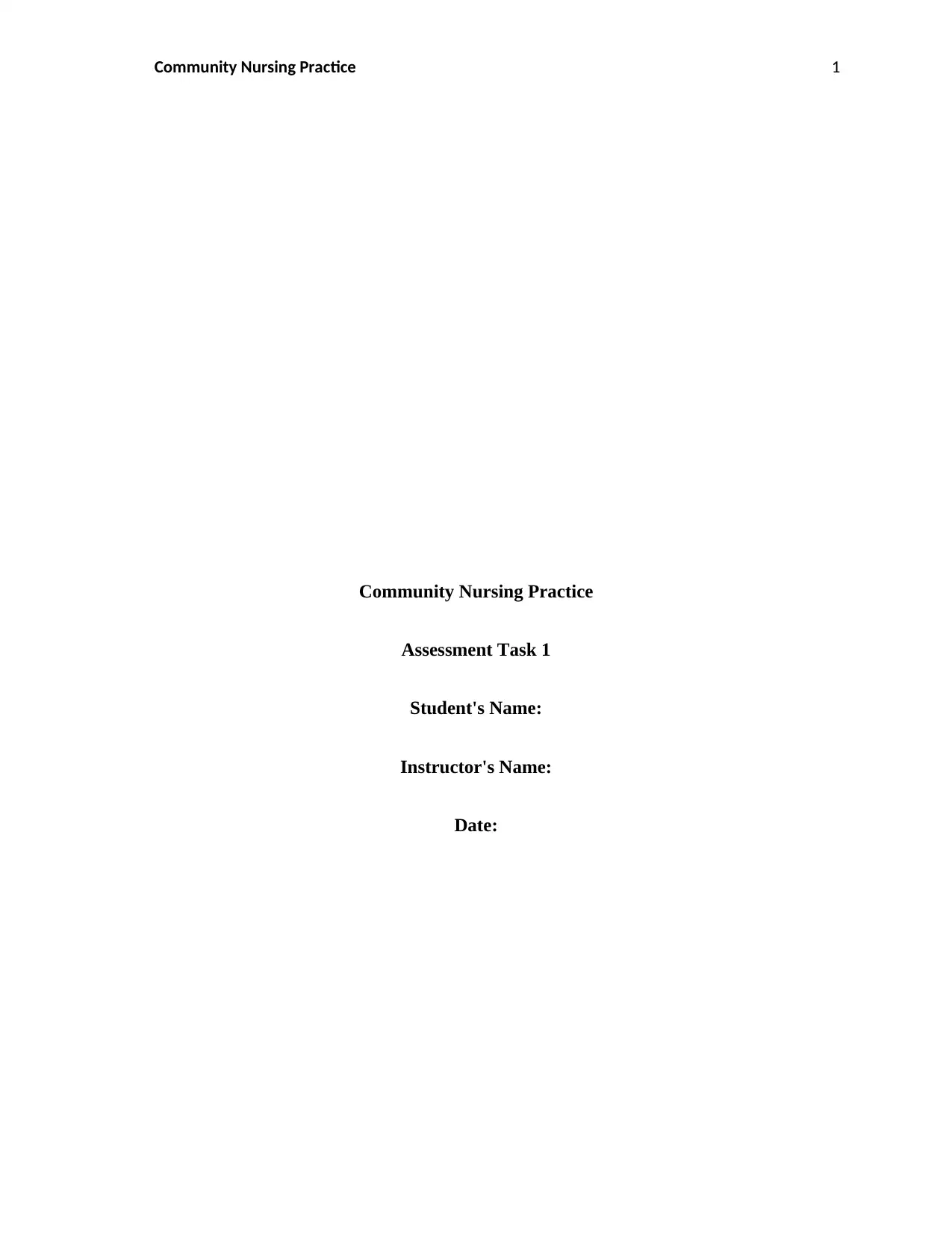
Community Nursing Practice 1
Community Nursing Practice
Assessment Task 1
Student's Name:
Instructor's Name:
Date:
Community Nursing Practice
Assessment Task 1
Student's Name:
Instructor's Name:
Date:
Paraphrase This Document
Need a fresh take? Get an instant paraphrase of this document with our AI Paraphraser
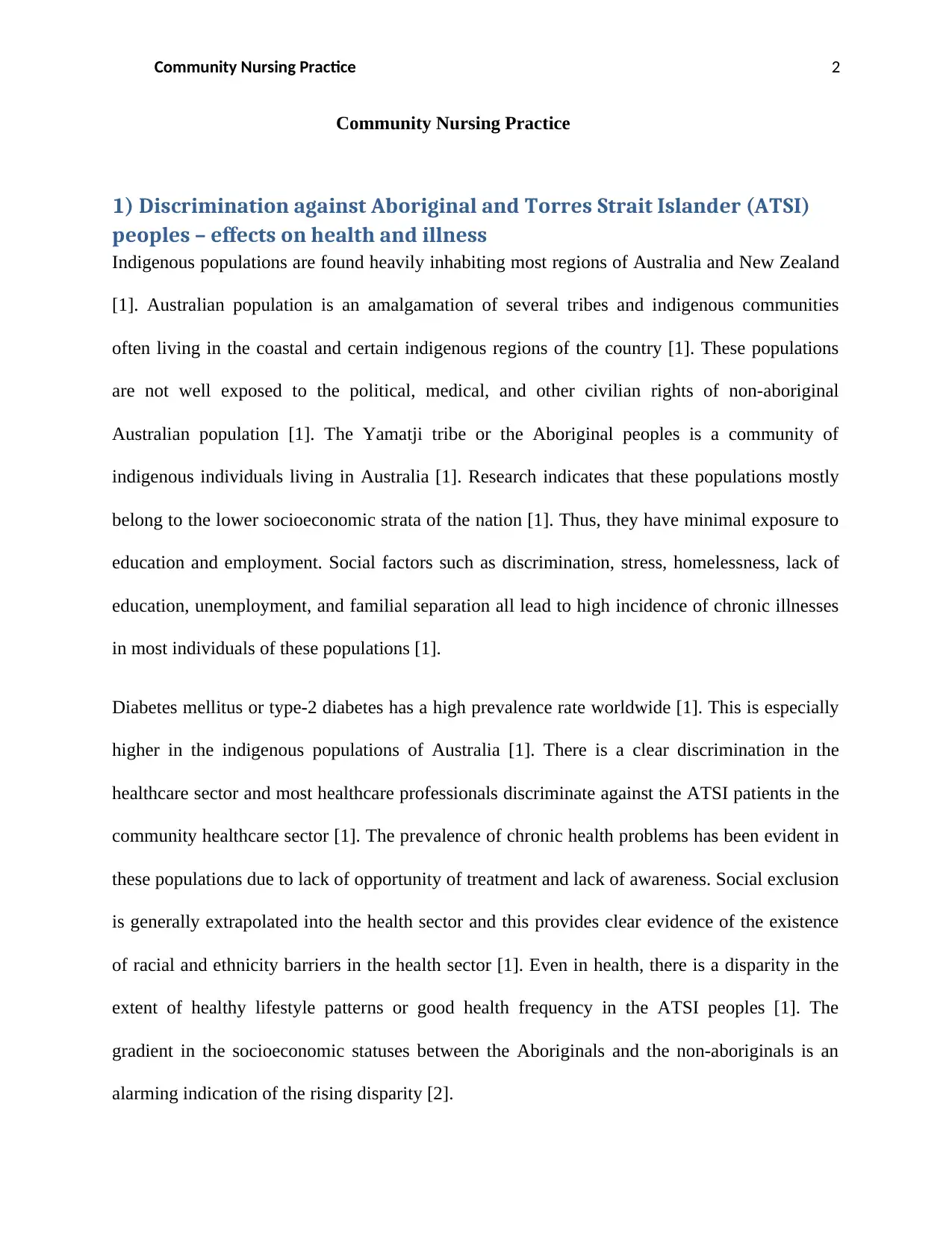
Community Nursing Practice 2
Community Nursing Practice
1) Discrimination against Aboriginal and Torres Strait Islander (ATSI)
peoples – effects on health and illness
Indigenous populations are found heavily inhabiting most regions of Australia and New Zealand
[1]. Australian population is an amalgamation of several tribes and indigenous communities
often living in the coastal and certain indigenous regions of the country [1]. These populations
are not well exposed to the political, medical, and other civilian rights of non-aboriginal
Australian population [1]. The Yamatji tribe or the Aboriginal peoples is a community of
indigenous individuals living in Australia [1]. Research indicates that these populations mostly
belong to the lower socioeconomic strata of the nation [1]. Thus, they have minimal exposure to
education and employment. Social factors such as discrimination, stress, homelessness, lack of
education, unemployment, and familial separation all lead to high incidence of chronic illnesses
in most individuals of these populations [1].
Diabetes mellitus or type-2 diabetes has a high prevalence rate worldwide [1]. This is especially
higher in the indigenous populations of Australia [1]. There is a clear discrimination in the
healthcare sector and most healthcare professionals discriminate against the ATSI patients in the
community healthcare sector [1]. The prevalence of chronic health problems has been evident in
these populations due to lack of opportunity of treatment and lack of awareness. Social exclusion
is generally extrapolated into the health sector and this provides clear evidence of the existence
of racial and ethnicity barriers in the health sector [1]. Even in health, there is a disparity in the
extent of healthy lifestyle patterns or good health frequency in the ATSI peoples [1]. The
gradient in the socioeconomic statuses between the Aboriginals and the non-aboriginals is an
alarming indication of the rising disparity [2].
Community Nursing Practice
1) Discrimination against Aboriginal and Torres Strait Islander (ATSI)
peoples – effects on health and illness
Indigenous populations are found heavily inhabiting most regions of Australia and New Zealand
[1]. Australian population is an amalgamation of several tribes and indigenous communities
often living in the coastal and certain indigenous regions of the country [1]. These populations
are not well exposed to the political, medical, and other civilian rights of non-aboriginal
Australian population [1]. The Yamatji tribe or the Aboriginal peoples is a community of
indigenous individuals living in Australia [1]. Research indicates that these populations mostly
belong to the lower socioeconomic strata of the nation [1]. Thus, they have minimal exposure to
education and employment. Social factors such as discrimination, stress, homelessness, lack of
education, unemployment, and familial separation all lead to high incidence of chronic illnesses
in most individuals of these populations [1].
Diabetes mellitus or type-2 diabetes has a high prevalence rate worldwide [1]. This is especially
higher in the indigenous populations of Australia [1]. There is a clear discrimination in the
healthcare sector and most healthcare professionals discriminate against the ATSI patients in the
community healthcare sector [1]. The prevalence of chronic health problems has been evident in
these populations due to lack of opportunity of treatment and lack of awareness. Social exclusion
is generally extrapolated into the health sector and this provides clear evidence of the existence
of racial and ethnicity barriers in the health sector [1]. Even in health, there is a disparity in the
extent of healthy lifestyle patterns or good health frequency in the ATSI peoples [1]. The
gradient in the socioeconomic statuses between the Aboriginals and the non-aboriginals is an
alarming indication of the rising disparity [2].
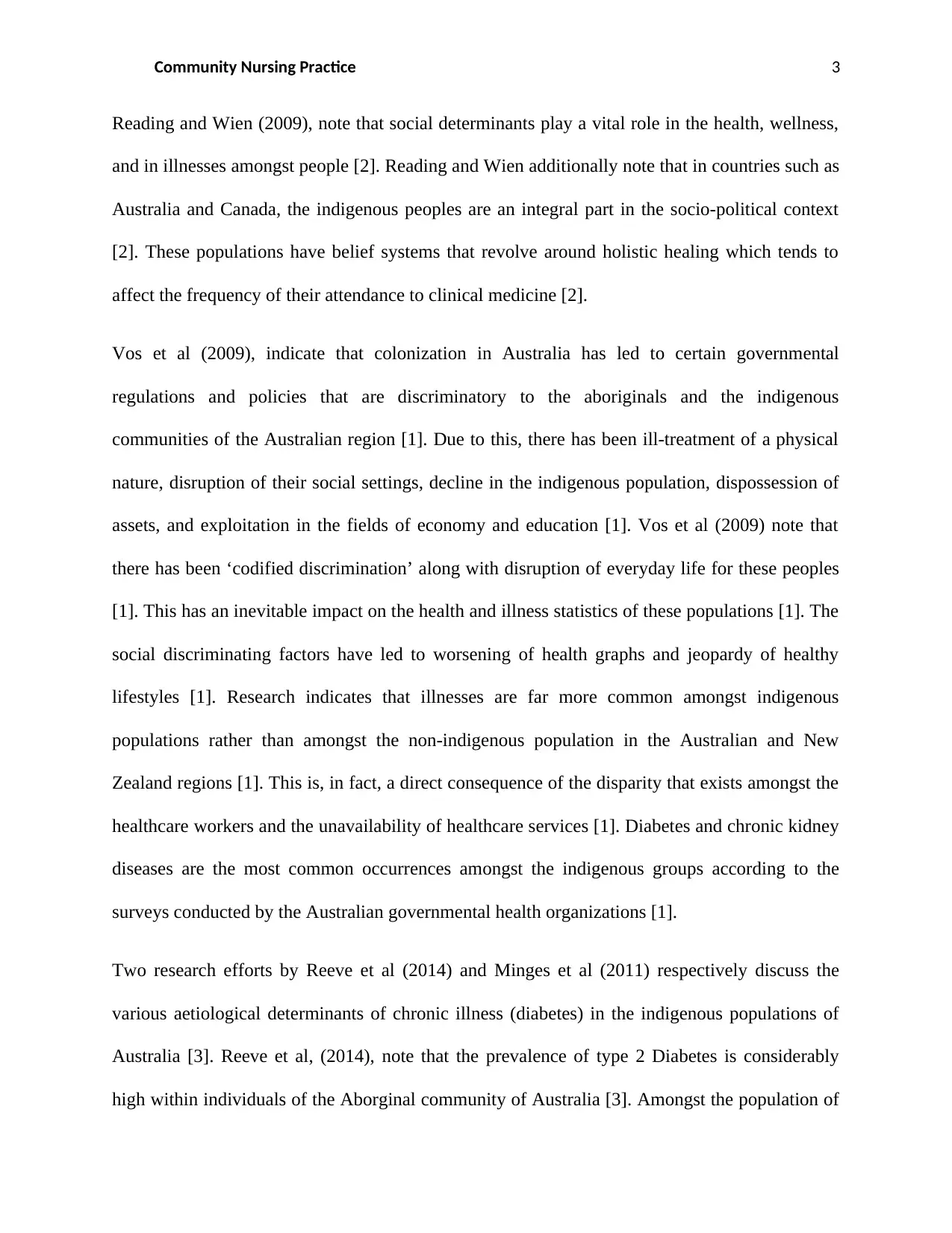
Community Nursing Practice 3
Reading and Wien (2009), note that social determinants play a vital role in the health, wellness,
and in illnesses amongst people [2]. Reading and Wien additionally note that in countries such as
Australia and Canada, the indigenous peoples are an integral part in the socio-political context
[2]. These populations have belief systems that revolve around holistic healing which tends to
affect the frequency of their attendance to clinical medicine [2].
Vos et al (2009), indicate that colonization in Australia has led to certain governmental
regulations and policies that are discriminatory to the aboriginals and the indigenous
communities of the Australian region [1]. Due to this, there has been ill-treatment of a physical
nature, disruption of their social settings, decline in the indigenous population, dispossession of
assets, and exploitation in the fields of economy and education [1]. Vos et al (2009) note that
there has been ‘codified discrimination’ along with disruption of everyday life for these peoples
[1]. This has an inevitable impact on the health and illness statistics of these populations [1]. The
social discriminating factors have led to worsening of health graphs and jeopardy of healthy
lifestyles [1]. Research indicates that illnesses are far more common amongst indigenous
populations rather than amongst the non-indigenous population in the Australian and New
Zealand regions [1]. This is, in fact, a direct consequence of the disparity that exists amongst the
healthcare workers and the unavailability of healthcare services [1]. Diabetes and chronic kidney
diseases are the most common occurrences amongst the indigenous groups according to the
surveys conducted by the Australian governmental health organizations [1].
Two research efforts by Reeve et al (2014) and Minges et al (2011) respectively discuss the
various aetiological determinants of chronic illness (diabetes) in the indigenous populations of
Australia [3]. Reeve et al, (2014), note that the prevalence of type 2 Diabetes is considerably
high within individuals of the Aborginal community of Australia [3]. Amongst the population of
Reading and Wien (2009), note that social determinants play a vital role in the health, wellness,
and in illnesses amongst people [2]. Reading and Wien additionally note that in countries such as
Australia and Canada, the indigenous peoples are an integral part in the socio-political context
[2]. These populations have belief systems that revolve around holistic healing which tends to
affect the frequency of their attendance to clinical medicine [2].
Vos et al (2009), indicate that colonization in Australia has led to certain governmental
regulations and policies that are discriminatory to the aboriginals and the indigenous
communities of the Australian region [1]. Due to this, there has been ill-treatment of a physical
nature, disruption of their social settings, decline in the indigenous population, dispossession of
assets, and exploitation in the fields of economy and education [1]. Vos et al (2009) note that
there has been ‘codified discrimination’ along with disruption of everyday life for these peoples
[1]. This has an inevitable impact on the health and illness statistics of these populations [1]. The
social discriminating factors have led to worsening of health graphs and jeopardy of healthy
lifestyles [1]. Research indicates that illnesses are far more common amongst indigenous
populations rather than amongst the non-indigenous population in the Australian and New
Zealand regions [1]. This is, in fact, a direct consequence of the disparity that exists amongst the
healthcare workers and the unavailability of healthcare services [1]. Diabetes and chronic kidney
diseases are the most common occurrences amongst the indigenous groups according to the
surveys conducted by the Australian governmental health organizations [1].
Two research efforts by Reeve et al (2014) and Minges et al (2011) respectively discuss the
various aetiological determinants of chronic illness (diabetes) in the indigenous populations of
Australia [3]. Reeve et al, (2014), note that the prevalence of type 2 Diabetes is considerably
high within individuals of the Aborginal community of Australia [3]. Amongst the population of
⊘ This is a preview!⊘
Do you want full access?
Subscribe today to unlock all pages.

Trusted by 1+ million students worldwide
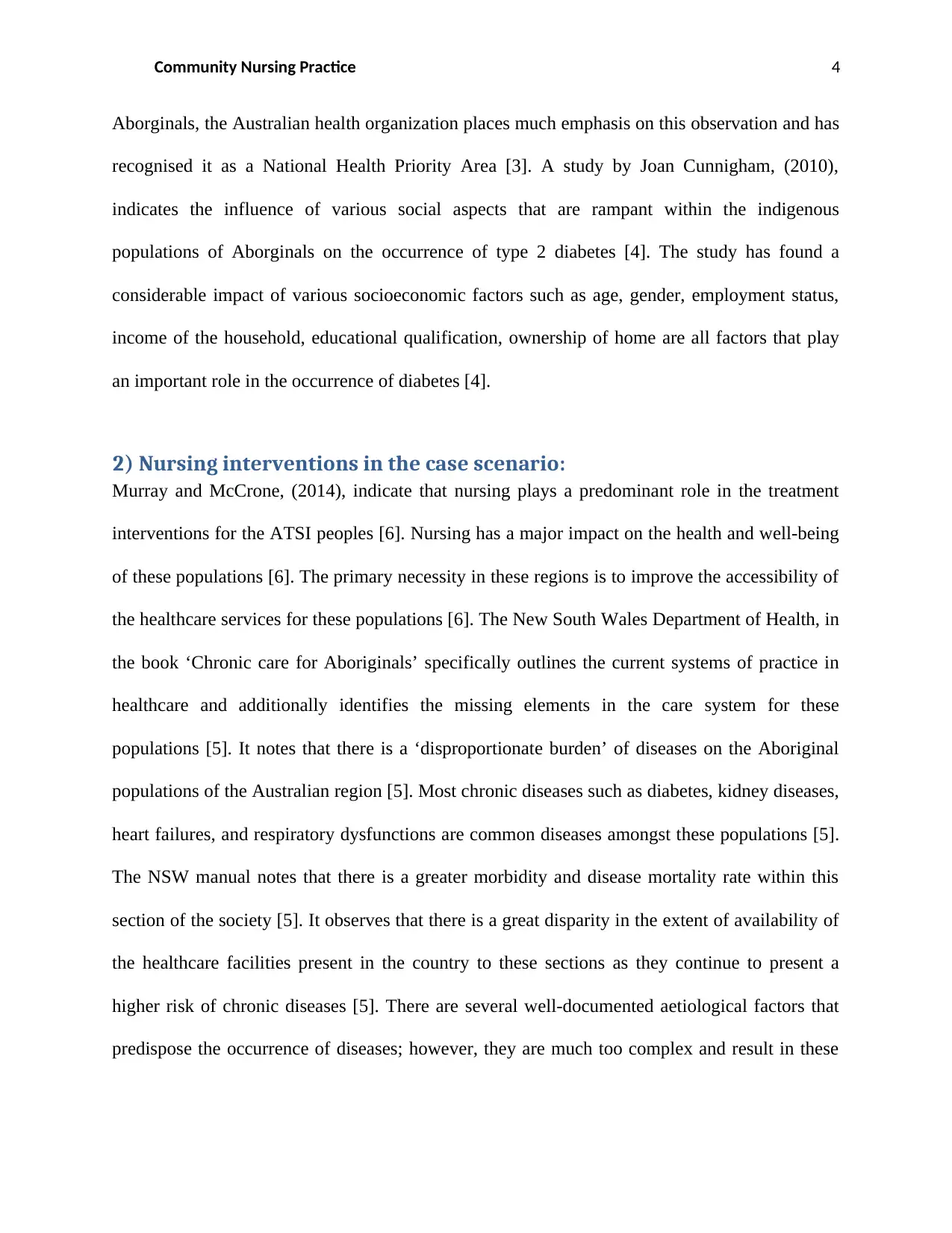
Community Nursing Practice 4
Aborginals, the Australian health organization places much emphasis on this observation and has
recognised it as a National Health Priority Area [3]. A study by Joan Cunnigham, (2010),
indicates the influence of various social aspects that are rampant within the indigenous
populations of Aborginals on the occurrence of type 2 diabetes [4]. The study has found a
considerable impact of various socioeconomic factors such as age, gender, employment status,
income of the household, educational qualification, ownership of home are all factors that play
an important role in the occurrence of diabetes [4].
2) Nursing interventions in the case scenario:
Murray and McCrone, (2014), indicate that nursing plays a predominant role in the treatment
interventions for the ATSI peoples [6]. Nursing has a major impact on the health and well-being
of these populations [6]. The primary necessity in these regions is to improve the accessibility of
the healthcare services for these populations [6]. The New South Wales Department of Health, in
the book ‘Chronic care for Aboriginals’ specifically outlines the current systems of practice in
healthcare and additionally identifies the missing elements in the care system for these
populations [5]. It notes that there is a ‘disproportionate burden’ of diseases on the Aboriginal
populations of the Australian region [5]. Most chronic diseases such as diabetes, kidney diseases,
heart failures, and respiratory dysfunctions are common diseases amongst these populations [5].
The NSW manual notes that there is a greater morbidity and disease mortality rate within this
section of the society [5]. It observes that there is a great disparity in the extent of availability of
the healthcare facilities present in the country to these sections as they continue to present a
higher risk of chronic diseases [5]. There are several well-documented aetiological factors that
predispose the occurrence of diseases; however, they are much too complex and result in these
Aborginals, the Australian health organization places much emphasis on this observation and has
recognised it as a National Health Priority Area [3]. A study by Joan Cunnigham, (2010),
indicates the influence of various social aspects that are rampant within the indigenous
populations of Aborginals on the occurrence of type 2 diabetes [4]. The study has found a
considerable impact of various socioeconomic factors such as age, gender, employment status,
income of the household, educational qualification, ownership of home are all factors that play
an important role in the occurrence of diabetes [4].
2) Nursing interventions in the case scenario:
Murray and McCrone, (2014), indicate that nursing plays a predominant role in the treatment
interventions for the ATSI peoples [6]. Nursing has a major impact on the health and well-being
of these populations [6]. The primary necessity in these regions is to improve the accessibility of
the healthcare services for these populations [6]. The New South Wales Department of Health, in
the book ‘Chronic care for Aboriginals’ specifically outlines the current systems of practice in
healthcare and additionally identifies the missing elements in the care system for these
populations [5]. It notes that there is a ‘disproportionate burden’ of diseases on the Aboriginal
populations of the Australian region [5]. Most chronic diseases such as diabetes, kidney diseases,
heart failures, and respiratory dysfunctions are common diseases amongst these populations [5].
The NSW manual notes that there is a greater morbidity and disease mortality rate within this
section of the society [5]. It observes that there is a great disparity in the extent of availability of
the healthcare facilities present in the country to these sections as they continue to present a
higher risk of chronic diseases [5]. There are several well-documented aetiological factors that
predispose the occurrence of diseases; however, they are much too complex and result in these
Paraphrase This Document
Need a fresh take? Get an instant paraphrase of this document with our AI Paraphraser
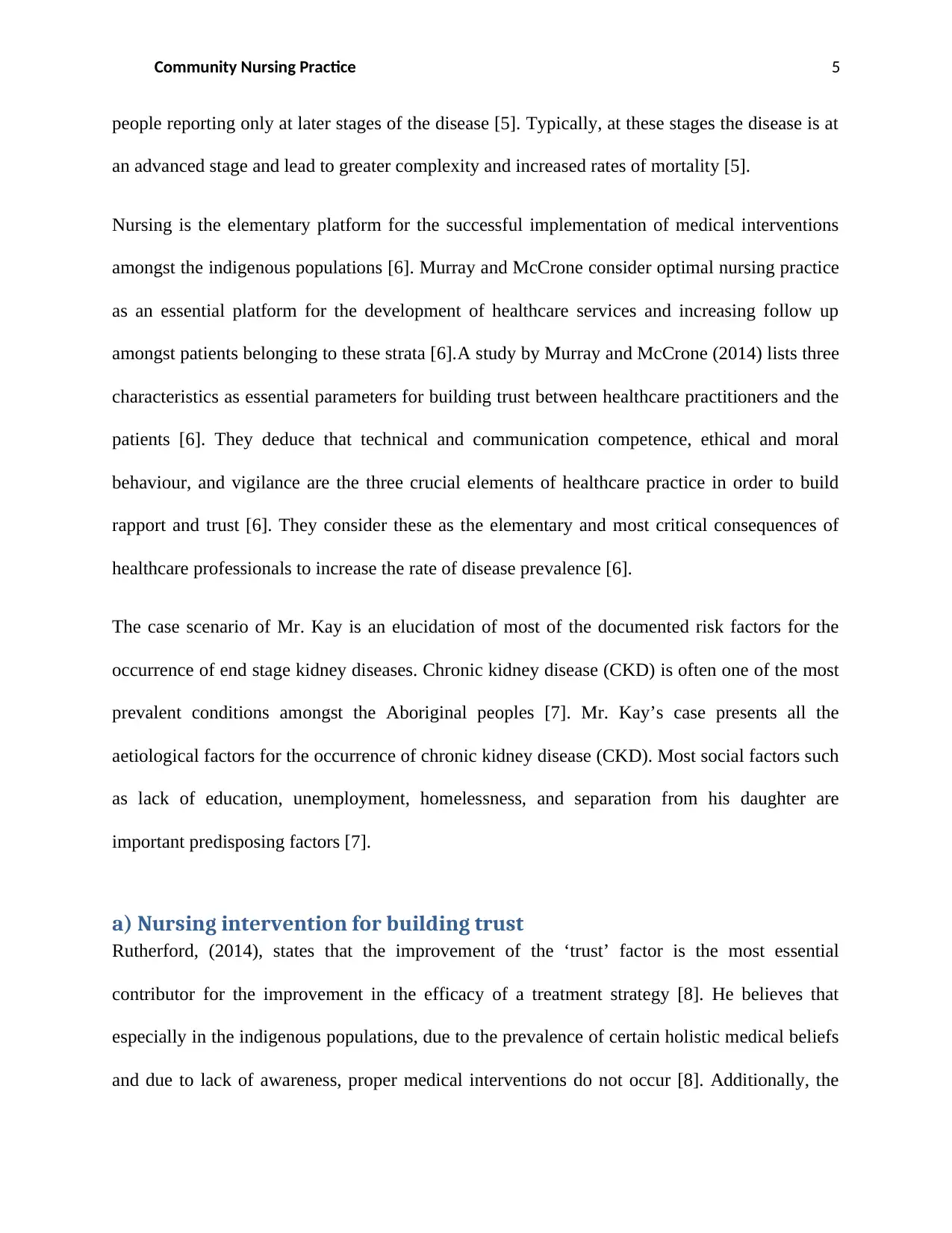
Community Nursing Practice 5
people reporting only at later stages of the disease [5]. Typically, at these stages the disease is at
an advanced stage and lead to greater complexity and increased rates of mortality [5].
Nursing is the elementary platform for the successful implementation of medical interventions
amongst the indigenous populations [6]. Murray and McCrone consider optimal nursing practice
as an essential platform for the development of healthcare services and increasing follow up
amongst patients belonging to these strata [6].A study by Murray and McCrone (2014) lists three
characteristics as essential parameters for building trust between healthcare practitioners and the
patients [6]. They deduce that technical and communication competence, ethical and moral
behaviour, and vigilance are the three crucial elements of healthcare practice in order to build
rapport and trust [6]. They consider these as the elementary and most critical consequences of
healthcare professionals to increase the rate of disease prevalence [6].
The case scenario of Mr. Kay is an elucidation of most of the documented risk factors for the
occurrence of end stage kidney diseases. Chronic kidney disease (CKD) is often one of the most
prevalent conditions amongst the Aboriginal peoples [7]. Mr. Kay’s case presents all the
aetiological factors for the occurrence of chronic kidney disease (CKD). Most social factors such
as lack of education, unemployment, homelessness, and separation from his daughter are
important predisposing factors [7].
a) Nursing intervention for building trust
Rutherford, (2014), states that the improvement of the ‘trust’ factor is the most essential
contributor for the improvement in the efficacy of a treatment strategy [8]. He believes that
especially in the indigenous populations, due to the prevalence of certain holistic medical beliefs
and due to lack of awareness, proper medical interventions do not occur [8]. Additionally, the
people reporting only at later stages of the disease [5]. Typically, at these stages the disease is at
an advanced stage and lead to greater complexity and increased rates of mortality [5].
Nursing is the elementary platform for the successful implementation of medical interventions
amongst the indigenous populations [6]. Murray and McCrone consider optimal nursing practice
as an essential platform for the development of healthcare services and increasing follow up
amongst patients belonging to these strata [6].A study by Murray and McCrone (2014) lists three
characteristics as essential parameters for building trust between healthcare practitioners and the
patients [6]. They deduce that technical and communication competence, ethical and moral
behaviour, and vigilance are the three crucial elements of healthcare practice in order to build
rapport and trust [6]. They consider these as the elementary and most critical consequences of
healthcare professionals to increase the rate of disease prevalence [6].
The case scenario of Mr. Kay is an elucidation of most of the documented risk factors for the
occurrence of end stage kidney diseases. Chronic kidney disease (CKD) is often one of the most
prevalent conditions amongst the Aboriginal peoples [7]. Mr. Kay’s case presents all the
aetiological factors for the occurrence of chronic kidney disease (CKD). Most social factors such
as lack of education, unemployment, homelessness, and separation from his daughter are
important predisposing factors [7].
a) Nursing intervention for building trust
Rutherford, (2014), states that the improvement of the ‘trust’ factor is the most essential
contributor for the improvement in the efficacy of a treatment strategy [8]. He believes that
especially in the indigenous populations, due to the prevalence of certain holistic medical beliefs
and due to lack of awareness, proper medical interventions do not occur [8]. Additionally, the
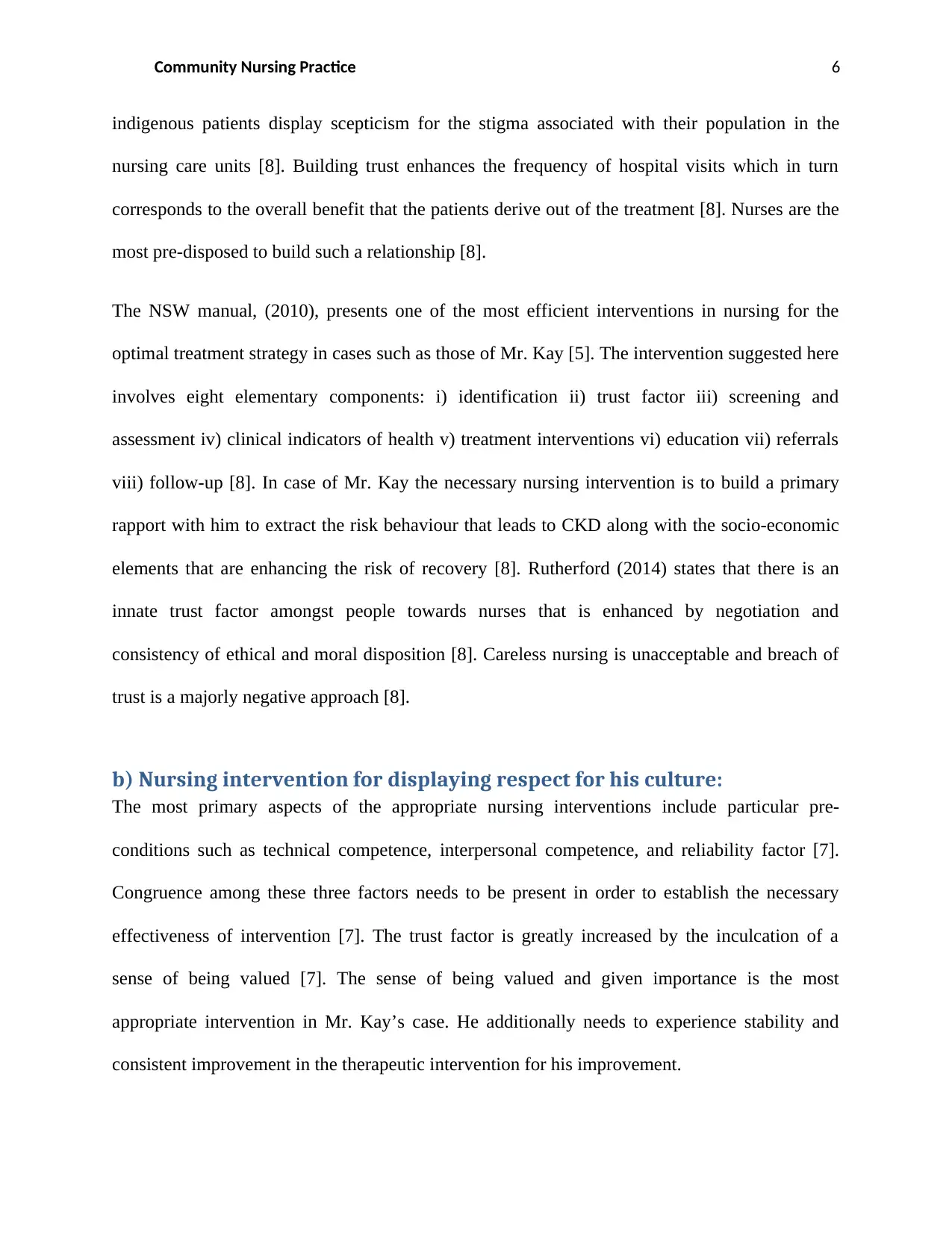
Community Nursing Practice 6
indigenous patients display scepticism for the stigma associated with their population in the
nursing care units [8]. Building trust enhances the frequency of hospital visits which in turn
corresponds to the overall benefit that the patients derive out of the treatment [8]. Nurses are the
most pre-disposed to build such a relationship [8].
The NSW manual, (2010), presents one of the most efficient interventions in nursing for the
optimal treatment strategy in cases such as those of Mr. Kay [5]. The intervention suggested here
involves eight elementary components: i) identification ii) trust factor iii) screening and
assessment iv) clinical indicators of health v) treatment interventions vi) education vii) referrals
viii) follow-up [8]. In case of Mr. Kay the necessary nursing intervention is to build a primary
rapport with him to extract the risk behaviour that leads to CKD along with the socio-economic
elements that are enhancing the risk of recovery [8]. Rutherford (2014) states that there is an
innate trust factor amongst people towards nurses that is enhanced by negotiation and
consistency of ethical and moral disposition [8]. Careless nursing is unacceptable and breach of
trust is a majorly negative approach [8].
b) Nursing intervention for displaying respect for his culture:
The most primary aspects of the appropriate nursing interventions include particular pre-
conditions such as technical competence, interpersonal competence, and reliability factor [7].
Congruence among these three factors needs to be present in order to establish the necessary
effectiveness of intervention [7]. The trust factor is greatly increased by the inculcation of a
sense of being valued [7]. The sense of being valued and given importance is the most
appropriate intervention in Mr. Kay’s case. He additionally needs to experience stability and
consistent improvement in the therapeutic intervention for his improvement.
indigenous patients display scepticism for the stigma associated with their population in the
nursing care units [8]. Building trust enhances the frequency of hospital visits which in turn
corresponds to the overall benefit that the patients derive out of the treatment [8]. Nurses are the
most pre-disposed to build such a relationship [8].
The NSW manual, (2010), presents one of the most efficient interventions in nursing for the
optimal treatment strategy in cases such as those of Mr. Kay [5]. The intervention suggested here
involves eight elementary components: i) identification ii) trust factor iii) screening and
assessment iv) clinical indicators of health v) treatment interventions vi) education vii) referrals
viii) follow-up [8]. In case of Mr. Kay the necessary nursing intervention is to build a primary
rapport with him to extract the risk behaviour that leads to CKD along with the socio-economic
elements that are enhancing the risk of recovery [8]. Rutherford (2014) states that there is an
innate trust factor amongst people towards nurses that is enhanced by negotiation and
consistency of ethical and moral disposition [8]. Careless nursing is unacceptable and breach of
trust is a majorly negative approach [8].
b) Nursing intervention for displaying respect for his culture:
The most primary aspects of the appropriate nursing interventions include particular pre-
conditions such as technical competence, interpersonal competence, and reliability factor [7].
Congruence among these three factors needs to be present in order to establish the necessary
effectiveness of intervention [7]. The trust factor is greatly increased by the inculcation of a
sense of being valued [7]. The sense of being valued and given importance is the most
appropriate intervention in Mr. Kay’s case. He additionally needs to experience stability and
consistent improvement in the therapeutic intervention for his improvement.
⊘ This is a preview!⊘
Do you want full access?
Subscribe today to unlock all pages.

Trusted by 1+ million students worldwide
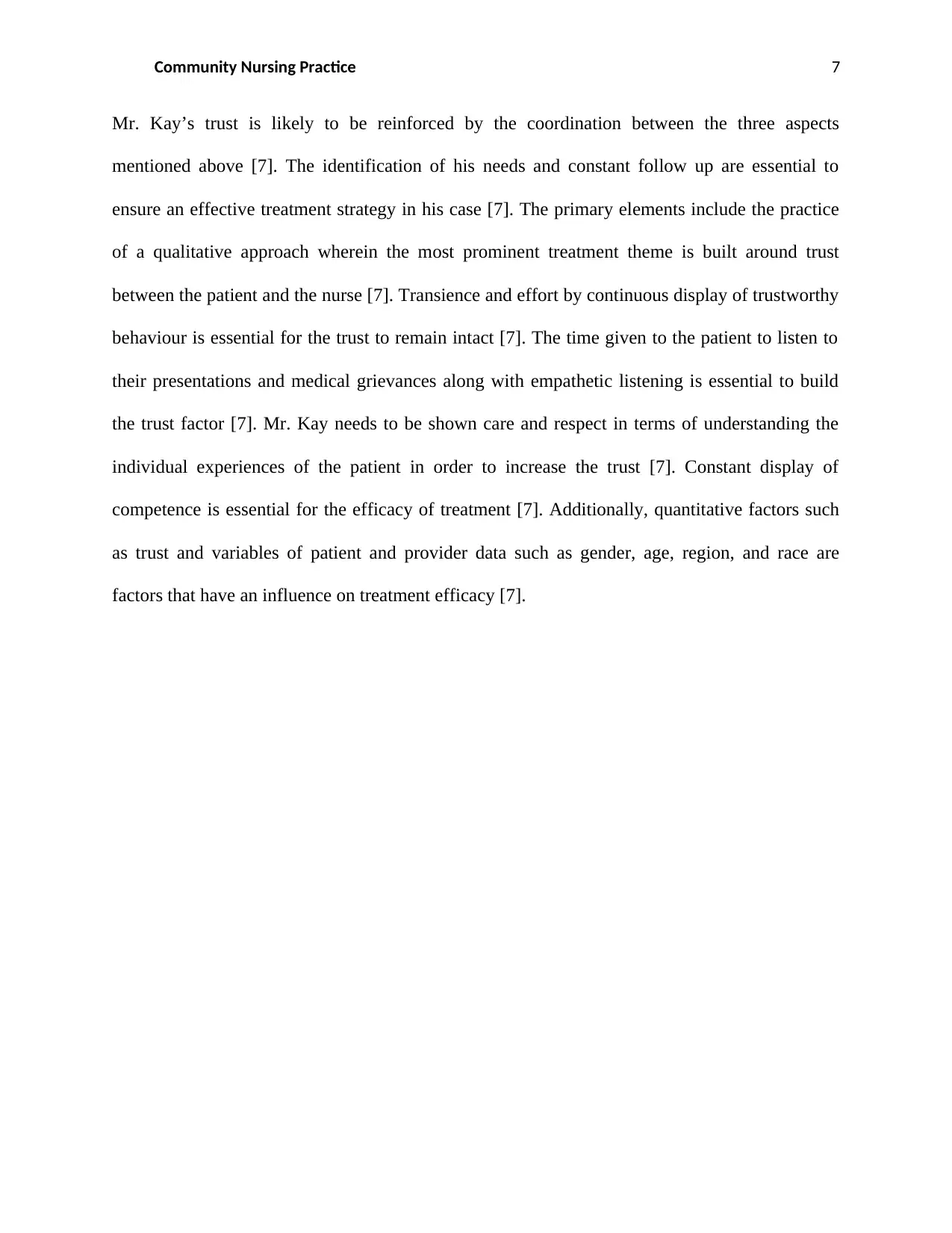
Community Nursing Practice 7
Mr. Kay’s trust is likely to be reinforced by the coordination between the three aspects
mentioned above [7]. The identification of his needs and constant follow up are essential to
ensure an effective treatment strategy in his case [7]. The primary elements include the practice
of a qualitative approach wherein the most prominent treatment theme is built around trust
between the patient and the nurse [7]. Transience and effort by continuous display of trustworthy
behaviour is essential for the trust to remain intact [7]. The time given to the patient to listen to
their presentations and medical grievances along with empathetic listening is essential to build
the trust factor [7]. Mr. Kay needs to be shown care and respect in terms of understanding the
individual experiences of the patient in order to increase the trust [7]. Constant display of
competence is essential for the efficacy of treatment [7]. Additionally, quantitative factors such
as trust and variables of patient and provider data such as gender, age, region, and race are
factors that have an influence on treatment efficacy [7].
Mr. Kay’s trust is likely to be reinforced by the coordination between the three aspects
mentioned above [7]. The identification of his needs and constant follow up are essential to
ensure an effective treatment strategy in his case [7]. The primary elements include the practice
of a qualitative approach wherein the most prominent treatment theme is built around trust
between the patient and the nurse [7]. Transience and effort by continuous display of trustworthy
behaviour is essential for the trust to remain intact [7]. The time given to the patient to listen to
their presentations and medical grievances along with empathetic listening is essential to build
the trust factor [7]. Mr. Kay needs to be shown care and respect in terms of understanding the
individual experiences of the patient in order to increase the trust [7]. Constant display of
competence is essential for the efficacy of treatment [7]. Additionally, quantitative factors such
as trust and variables of patient and provider data such as gender, age, region, and race are
factors that have an influence on treatment efficacy [7].
Paraphrase This Document
Need a fresh take? Get an instant paraphrase of this document with our AI Paraphraser
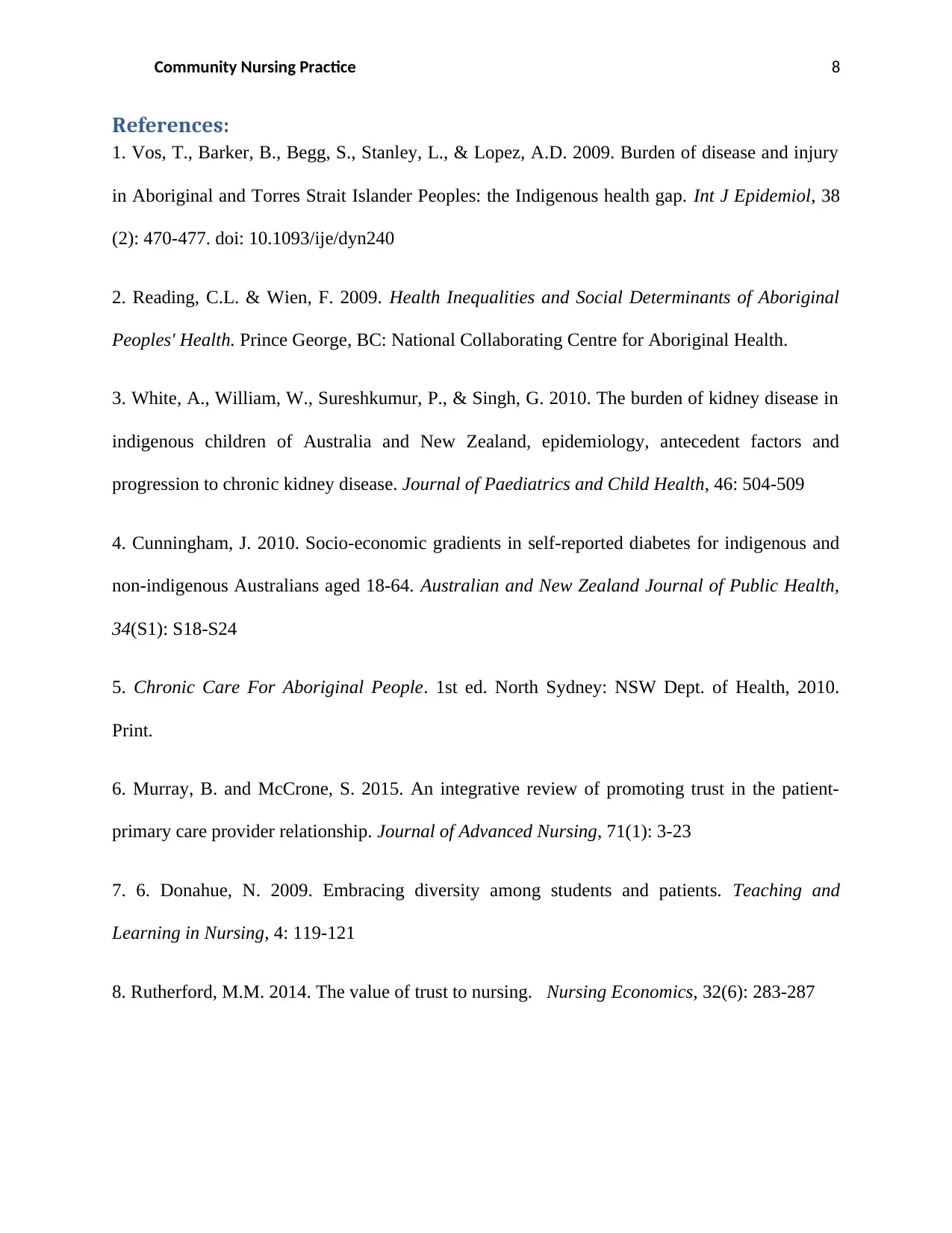
Community Nursing Practice 8
References:
1. Vos, T., Barker, B., Begg, S., Stanley, L., & Lopez, A.D. 2009. Burden of disease and injury
in Aboriginal and Torres Strait Islander Peoples: the Indigenous health gap. Int J Epidemiol, 38
(2): 470-477. doi: 10.1093/ije/dyn240
2. Reading, C.L. & Wien, F. 2009. Health Inequalities and Social Determinants of Aboriginal
Peoples' Health. Prince George, BC: National Collaborating Centre for Aboriginal Health.
3. White, A., William, W., Sureshkumur, P., & Singh, G. 2010. The burden of kidney disease in
indigenous children of Australia and New Zealand, epidemiology, antecedent factors and
progression to chronic kidney disease. Journal of Paediatrics and Child Health, 46: 504-509
4. Cunningham, J. 2010. Socio-economic gradients in self-reported diabetes for indigenous and
non-indigenous Australians aged 18-64. Australian and New Zealand Journal of Public Health,
34(S1): S18-S24
5. Chronic Care For Aboriginal People. 1st ed. North Sydney: NSW Dept. of Health, 2010.
Print.
6. Murray, B. and McCrone, S. 2015. An integrative review of promoting trust in the patient-
primary care provider relationship. Journal of Advanced Nursing, 71(1): 3-23
7. 6. Donahue, N. 2009. Embracing diversity among students and patients. Teaching and
Learning in Nursing, 4: 119-121
8. Rutherford, M.M. 2014. The value of trust to nursing. Nursing Economics, 32(6): 283-287
References:
1. Vos, T., Barker, B., Begg, S., Stanley, L., & Lopez, A.D. 2009. Burden of disease and injury
in Aboriginal and Torres Strait Islander Peoples: the Indigenous health gap. Int J Epidemiol, 38
(2): 470-477. doi: 10.1093/ije/dyn240
2. Reading, C.L. & Wien, F. 2009. Health Inequalities and Social Determinants of Aboriginal
Peoples' Health. Prince George, BC: National Collaborating Centre for Aboriginal Health.
3. White, A., William, W., Sureshkumur, P., & Singh, G. 2010. The burden of kidney disease in
indigenous children of Australia and New Zealand, epidemiology, antecedent factors and
progression to chronic kidney disease. Journal of Paediatrics and Child Health, 46: 504-509
4. Cunningham, J. 2010. Socio-economic gradients in self-reported diabetes for indigenous and
non-indigenous Australians aged 18-64. Australian and New Zealand Journal of Public Health,
34(S1): S18-S24
5. Chronic Care For Aboriginal People. 1st ed. North Sydney: NSW Dept. of Health, 2010.
Print.
6. Murray, B. and McCrone, S. 2015. An integrative review of promoting trust in the patient-
primary care provider relationship. Journal of Advanced Nursing, 71(1): 3-23
7. 6. Donahue, N. 2009. Embracing diversity among students and patients. Teaching and
Learning in Nursing, 4: 119-121
8. Rutherford, M.M. 2014. The value of trust to nursing. Nursing Economics, 32(6): 283-287
1 out of 8
Related Documents
Your All-in-One AI-Powered Toolkit for Academic Success.
+13062052269
info@desklib.com
Available 24*7 on WhatsApp / Email
![[object Object]](/_next/static/media/star-bottom.7253800d.svg)
Unlock your academic potential
Copyright © 2020–2025 A2Z Services. All Rights Reserved. Developed and managed by ZUCOL.




